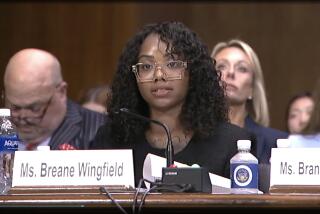RITES OF PASSAGE : Program Gives At-Risk Teen-Age Girls a Boost
Last fall, Crystal Evans, 13, faced expulsion after she and some friends were caught drinking alcohol on the campus of Stephen M. White Junior High School in Carson.
Then her counselor referred her to Rites of Passage, a 12-week-long pilot program aimed at building the self-esteem of troubled teen-age girls and showing them that there is an alternative to drugs, gangs and teen-age pregnancy.
Today, the same girl aspires to be a lawyer.
“Before (the class), I thought I didn’t care if I got in trouble; I just wanted to fit in the crowd,” said Crystal, who has twice refused offers to join gangs. “But now I see I do care.”
It was a hard-earned victory for Janice Garcia, the 30-year-old former gang member who ran the program.
“A lot of them don’t realize they are at risk” from drugs and gangs, even though many of them live in gang-infested neighborhoods and their parents openly abuse drugs or alcohol in their own homes, Garcia said Tuesday after the program’s last class. “To them, it’s just a part of growing up.”
The 19 girls who participated in Rites of Passage were referred to Garcia by counselors. About half of them are gang members. Most have used drugs and alcohol and are considered at risk of dropping out of school. Several are sexually active.
At first, the girls resisted the message, but most of them gradually softened, Garcia said.
During weekly classes of about 45 minutes each, the girls undertook several activities designed to make them more aware of their cultural, social and personal histories and build their self-esteem.
They made family trees, saw a video about gangs, listened to a lecture about AIDS, and had makeup and etiquette classes. They kept notebooks, learned strategies to cope with anger and organized a car wash to raise money for a graduation dinner at the Grand House in San Pedro on Tuesday night.
Wearing a smart red dress and well-coiffed hairstyle, Garcia seems at first glance worlds away from her young charges. Her account of her own involvement with drugs and gangs, however, rang true to the students.
Acting more as a mentor and friend than as a teacher, Garcia told them how painful it was to remove the tattoos she drunkenly agreed to get as a teen-ager. When the girls needed someone to talk to about everything from menstrual cramps to fears of being pregnant, she served as a trusted confidante.
In one instance, she helped persuade a student who had run away from home to return to her parents.
“She’s what really made me want to come home,” said Elsa Aguilar, 14. “She told me that being out on the street was not the right way, that a lot of runaways get killed, take drugs or get pregnant. I thought it would be easy out there. Now I know she was right.”
Rites of Passage was developed five years ago at the Youth and Family Center at Leuzinger High School in Lawndale to help teen-age fathers make the transition to manhood. The center has since moved to Inglewood.
The program was designed by Ron Johnson, a former New York gang member and consultant on at-risk youth for the California Department of Education, who is writing a book about manhood for teen-age boys.
The premise of Rites of Passage is that many youngsters think adulthood is defined by gang involvement, drug use and even prison time, Johnson said in an interview.
In his years of working with troubled youngsters, Johnson identified several areas of growth or “rites of passage” that would offer troubled teen-agers a different understanding of the transition to adulthood, one that would involve personal, cultural, social, physical, economic and emotional growth.
Unlike other teen-age intervention programs that are organized around a single problem such as drug use or gangs or pregnancy, “Rites of Passage teaches kids to look at their entire lives,” Johnson said. The program is also designed to be relevant for all youngsters, regardless of race or ethnic background.
About 75 young men have completed a yearlong version of the program, and the state Department of Education is planning to test the 12-week version of the course in a pilot project at six schools, Johnson said. Before this year, however, the program had never been adapted to the needs of teen-age girls.
When the program captured the interest of the federally funded Community Reclamation Project, a program that works to strengthen the network of South Bay community groups fighting against drugs and gangs, Johnson agreed to create a version for girls and to train Garcia to be the coordinator.
Although school administrators supported the project, there were obstacles: The group had to search for an empty classroom every time it met and usually ran out of time before the day’s activities were complete.
During their last meeting, however, the obstacles seemed like mere inconveniences. When the girls anonymously evaluated the program, not one comment was negative.
“I learned to feel better about myself, how to get closer to Mom, Dad,” one girl wrote.
Another defined the ideas that had benefited her the most: “Drugs isn’t your life. Gangs wasn’t or isn’t fun.”
As the girls snacked on doughnuts and fruit juice, Garcia became teary-eyed as she struggled to find the words she hoped would make a lasting impression.
“This is the nicest thing I could have possibly done, to make an impact on you guys,” Garcia said. “Maybe down the line you’ll remember something I said: That even if you do have problems you can come out of them. It’s hard, but you can do whatever you want.”
More to Read
Sign up for Essential California
The most important California stories and recommendations in your inbox every morning.
You may occasionally receive promotional content from the Los Angeles Times.










